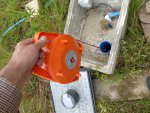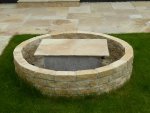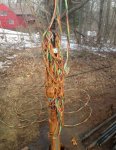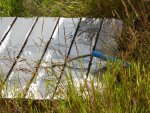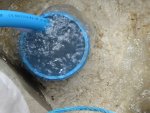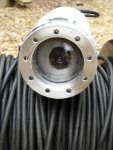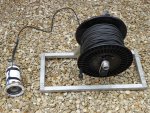Jeremy Harris
Senior Member
On another thread I took things off topic by looking at ways to measure water level in a borehole well. This thread is to hold those posts moved by admin (I hope) so please don't add posts here until the old posts have been moved over.
The challenge I have is wanting to measure the depth of water in a 53m deep water supply borehole. The resting water level is usually around 4m from the surface, but when the well is pumped very hard for long periods it can drop to around 11m below the surface. The pump sits at about 25m below the surface.
I would like to periodically measure the water level, just for reassurance that all is well, and to track any seasonal changes. At the moment I have to measure the water level by dropping a pair of wires down the hole, with a water conductivity switch on the end, that operates a beeper when it touches the surface of the water. I have markers on the wire that show me the depth.
--------------------------
From other thread ...
It's a pity those "time of flight" sensors don't have a longer distance measurement range. I've been wanting to put a simple water depth indicator on our borehole well for some time now. I know that the water level sits around 4m down when the well isn't being pumped, and that after prolonged pumping at the maximum pump rate (around 2000 litres per hour) the level drops to about 11m down, but it would be nice to have a simple monitor that shows the water level. The pump is around 25m down, so well below what I think is the worst case low level, and the well is 53m deep.
I like the idea of having a small, sealed, unit that just shines a laser down to the water surface and picks up the reflection. Easier to make watertight than an ultrasonic ranging system, and because the well is totally dark, the performance of any sensor should be improved.
Many years ago, I built a distance measuring system for doing cave surveys. That used a low frequency (a few hundred Hz, IIRC) sine wave modulated point source LED (one intended as a fibre optic driver) and collimated it to a near-parallel beam, with a single lens. I used a bigger lens (around 30mm in diameter) for the receiver, to focus the reflected light back to a photodiode. A sideways pinhole allowed some modulated light from the transmitter to also hit a reference photodiode. The signals were amplified by a pair of identical tuned amplifiers, rather like very low frequency radio IF amplifiers, then fed to a pair of identical threshold comparators. The difference in phase between the transmitted light and the received light gave the range, with pulses that could easily be measured by a small microprocessor.
I could build the same sort of system again, as I still have all the parts from the original survey unit, but it would be a bit large to fit under the well head cap (the well is roughly 120mm in diameter). I wonder if any of the modules mentioned here could be modified to do the job? My biggest problem last time was the optics, and I had an aluminium block machined up with two parallel holes, with small apertures for the LED/photodiodes and a rebate to take the lenses. I may just get one of those sensors with the optics and see if there's a way to modulate the thing at a few hundred Hz and do as I did before with the receiver.
The challenge I have is wanting to measure the depth of water in a 53m deep water supply borehole. The resting water level is usually around 4m from the surface, but when the well is pumped very hard for long periods it can drop to around 11m below the surface. The pump sits at about 25m below the surface.
I would like to periodically measure the water level, just for reassurance that all is well, and to track any seasonal changes. At the moment I have to measure the water level by dropping a pair of wires down the hole, with a water conductivity switch on the end, that operates a beeper when it touches the surface of the water. I have markers on the wire that show me the depth.
--------------------------
From other thread ...
It's a pity those "time of flight" sensors don't have a longer distance measurement range. I've been wanting to put a simple water depth indicator on our borehole well for some time now. I know that the water level sits around 4m down when the well isn't being pumped, and that after prolonged pumping at the maximum pump rate (around 2000 litres per hour) the level drops to about 11m down, but it would be nice to have a simple monitor that shows the water level. The pump is around 25m down, so well below what I think is the worst case low level, and the well is 53m deep.
I like the idea of having a small, sealed, unit that just shines a laser down to the water surface and picks up the reflection. Easier to make watertight than an ultrasonic ranging system, and because the well is totally dark, the performance of any sensor should be improved.
Many years ago, I built a distance measuring system for doing cave surveys. That used a low frequency (a few hundred Hz, IIRC) sine wave modulated point source LED (one intended as a fibre optic driver) and collimated it to a near-parallel beam, with a single lens. I used a bigger lens (around 30mm in diameter) for the receiver, to focus the reflected light back to a photodiode. A sideways pinhole allowed some modulated light from the transmitter to also hit a reference photodiode. The signals were amplified by a pair of identical tuned amplifiers, rather like very low frequency radio IF amplifiers, then fed to a pair of identical threshold comparators. The difference in phase between the transmitted light and the received light gave the range, with pulses that could easily be measured by a small microprocessor.
I could build the same sort of system again, as I still have all the parts from the original survey unit, but it would be a bit large to fit under the well head cap (the well is roughly 120mm in diameter). I wonder if any of the modules mentioned here could be modified to do the job? My biggest problem last time was the optics, and I had an aluminium block machined up with two parallel holes, with small apertures for the LED/photodiodes and a rebate to take the lenses. I may just get one of those sensors with the optics and see if there's a way to modulate the thing at a few hundred Hz and do as I did before with the receiver.
Last edited by a moderator:

